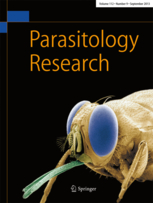Ver ítem
- xmlui.general.dspace_homeCentros e Institutos de InvestigaciónCICVyA. Centro de Investigación en Ciencias Veterinarias y AgronómicasInstituto de PatobiologíaArtículos científicosxmlui.ArtifactBrowser.ItemViewer.trail
- Inicio
- Centros e Institutos de Investigación
- CICVyA. Centro de Investigación en Ciencias Veterinarias y Agronómicas
- Instituto de Patobiología
- Artículos científicos
- Ver ítem
Development of a loop-mediated isothermal amplification (LAMP) and a direct LAMP for the specific detection of Nosema ceranae, a parasite of honey bees
Resumen
Nosema ceranae is a ubiquitous microsporidian pathogen infecting the midgut of honey bees. The infection causes bee nosemosis, a disease associated with malnutrition, dysentery, and lethargic behavior, and results in considerable economic losses in apiculture. The use of a rapid, sensitive, and inexpensive DNA-based molecular detection method assists in the surveillance and eventual control of this pathogen. To this end, a loop-mediated isothermal
[ver mas...]
Nosema ceranae is a ubiquitous microsporidian pathogen infecting the midgut of honey bees. The infection causes bee nosemosis, a disease associated with malnutrition, dysentery, and lethargic behavior, and results in considerable economic losses in apiculture. The use of a rapid, sensitive, and inexpensive DNA-based molecular detection method assists in the surveillance and eventual control of this pathogen. To this end, a loop-mediated isothermal amplification (LAMP) assay targeting the single-copy gene encoding the polar tube protein 3 (PTP3) has been developed. Genomic DNA of N. ceranae–infected forager bees sampled from distant geographic regions could be reliably amplified using the established LAMP assay. The N. ceranae-LAMP showed higher sensitivity than a classical reference PCR (98.6 vs 95.7%), when both approaches were applied to the detection of N. ceranae. LAMP detected a ten-fold lower infection rate than the reference PCR (1 pg vs 10 pg genomic DNA, respectively). In addition, we show highly specific and sensitive detection of N. ceranae from spore preparations in a direct LAMP format. No cross-reactions with genomic DNA and/or spores from N. apis, often co-infecting A. mellifera, or from N. bombi, infecting bumble bees, were observed. This low-cost and time-saving molecular detection method can be easily applied in simple laboratory settings, facilitating a rapid detection of N. ceranae in honey bees in epidemiological studies, surveillance and control, as well as evaluation of therapeutic measures against nosemosis.
[Cerrar]

Autor
Lannutti, Lucas;
Mira, Anabela;
Basualdo, Marina;
Rodriguez, Graciela Adriana;
Erler, Silvio;
Silva, Victoria Ayelén;
Gisder, Sebastian;
Genersch, Elke;
Florin-Christensen, Mónica;
Schnittger, Leonhard;
Fuente
Parasitology Research 119 : 3947-3956 (2020)
Fecha
2020-10
Editorial
Springer
ISSN
0932-0113
1432-1955
1432-1955
Documentos Relacionados
Formato
pdf
Tipo de documento
artículo
Proyectos
(ver más)
INTA/2019-PE-E1-I017-001/2019-PE-E1-I017-001/AR./DESARROLLO DEL SECTOR APÍCOLA ORGANIZADO, SUSTENTABLE Y COMPETITIVO
Palabras Claves
Derechos de acceso
Restringido
 Excepto donde se diga explicitamente, este item se publica bajo la siguiente descripción: Creative Commons Attribution-NonCommercial-ShareAlike 2.5 Unported (CC BY-NC-SA 2.5)
Excepto donde se diga explicitamente, este item se publica bajo la siguiente descripción: Creative Commons Attribution-NonCommercial-ShareAlike 2.5 Unported (CC BY-NC-SA 2.5)

